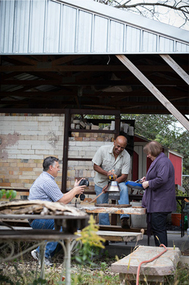On a recent off-campus trip to Ethiopia, Carleton environmental studies professor Tsegaye Nega brought students to the home of a 25-year-old woman named Fikerte.
Wherever she goes, her six-month old son goes—always clutching her back. This often means long hours for both in a tiny kitchen, standing or crouched in front of an open pit fire used to cook and heat the home.
“Because of this, you’re looking at smoke levels in the kitchen that are four times higher than what is recommended by the World Health Organization,” Nega says.
“So you see it and think, ‘Your son is breathing in all this smoke. He could be dead in a year.’ The mother knows this. But when asked about the pollution, she simply says, ‘What can we do? We have to eat.’”
Addressing a problem
Nega has made his share of off-campus trips to Africa since 2008. Yet the more he’s revisited the persistent environmental and health problems in his native Ethiopia, the more he realizes that merely dropping Carleton students into the abyss isn’t advancing the conversation.
This past winter’s trip aimed to do more. In December, Nega brought 14 Carls to work with villagers to replace Ethiopia’s open pit fires with small-scale energy efficient stoves that are better for their health and the environment.
Throughout Africa, fire pits are the only affordable method of cooking and home heating. About three billion people use dirty fuels like wood, animal dung, and coal—burned on open fires or in traditional stoves—according to the World Health Organization. The majority of those affected reside in Africa and Asia, with the resulting smoke prematurely killing about four million people a year.
“If one of the big sources of soot in a region is wood burning, inefficient home heating, and cooking, you can try to change the technology people are using,” says chemistry professor Deborah Gross. “Then you can attempt to have both a significant climate impact and a significant impact on the people who are no longer breathing as much of the smoke. It’s a win-win.”
First, Nega had to find a viable alternative for cooking and heating. After a conversation with science support specialist Randy Hoffner, the pair teamed up to make a micro gasifier stove—an inexpensive, efficient cook stove made from common hardware store material. Thanks to Gross and her fall 2015 Climate Science class, students also began measuring aerosol particles—Gross’ specialty—to help mark the health differences and redefine a long-ingrained process.
Forging campus connections was the easy part, as Nega soon found out.
The sheer logistics of getting gasifier stove parts to Ethiopia almost shut down the project before it began. Airport customs wouldn’t accept them as part of student luggage, as originally planned. Finally, after cutting through a ton of red tape, Nega managed to get last-minute shipments sent to a university in Addis Ababa, Ethiopia’s capital.
No easy solutions
Other problems cropped up in the field: Gasifier stove efficiency doesn’t mean much for locals or the environment unless the material used to burn them (for instance, sustainable wood pellets versus charcoal) is safer and more accessible. Also, once Ethiopians tried the stoves, they quickly ticked off a litany of problems—they were still too big for their small kitchens, they couldn’t maintain consistent heat for varied cooking needs, and perhaps most underestimated by the Carleton group, residents often didn’t feel safe using them.
This is the reality of field work, Nega says. You learn that just because you think you have a solution to a problem, what makes sense in a laboratory or classroom doesn’t always translate to the way real people live.
“I think from a student’s perspective, they can get disheartened quickly because they don’t realize that this is a trial. They tend to think, ‘We’ll give them the new stove and everyone will live a happy, perfect life,’” Nega says. “No, this is a complex problem. It’s also intensely personal now because the person that is affected is right in front of them.”
Nega credits his students with “never hesitating to carry through their job” despite some initial discouragement. The impoverished conditions also hit them hard, Nega says, and tests their ability to cope while seeing systemic problems that go far beyond giving money, food, or the shirt off one’s back.
Real engagement
As for Nega’s greater aim, the mission is no longer just tied to gasifier stoves. Surveys and data collected on the trip by students continue to influence the project.
When Nega isn’t busy tinkering with new stove prototypes, he’s crafting business proposals and raising capital for a pellet manufacturing plant in Ethiopia that will help solve the bigger issue he discovered—that without a more sustainable fuel source, a gasifier stove’s impact is still rendered meaningless. Nega has already committed $50,000 to the project and needs another $50,000 from investors.
“I told the students, your written paper from the trip, I didn’t just grade it. I used it to design new stoves, and I will continue to have students conduct research so we can do something about these larger issues,” Nega says.
“We like to say that colleges and universities are about developing students as good citizens. I always thought that’s what differentiated a place like Carleton from a bigger university—thinking about the connection between academics and real world engagement. We have an obligation to show students that.”
PROFILES IN TEACHING
Tsegaye Nega, Associate Professor of Environmental Studies
- At Carleton since 2002
- Education: Centro Universitario de Pinar del Rio, Cuba; University of Minnesota
- Sample courses taught: Global Food Systems, Biodiversity Conservation and Development
- Teaching and research interests: agriculture and ecology, urbanization and conservation, cultural studies
- Hometown: Ethiopia

